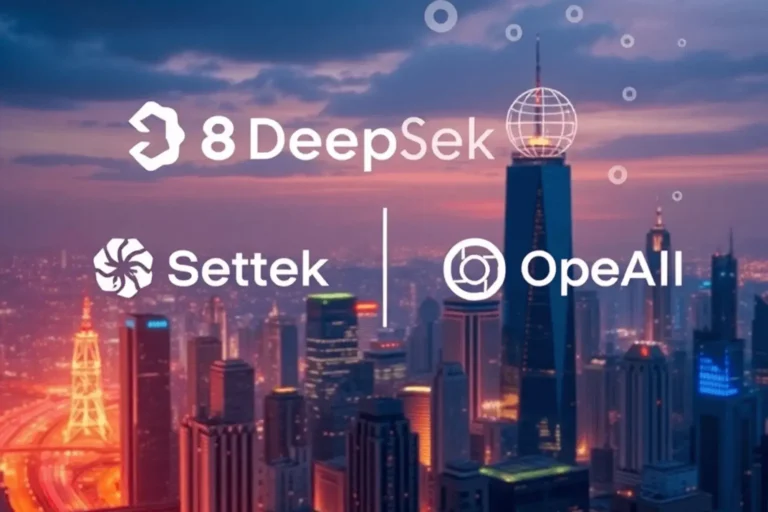The world of artificial intelligence (AI) is always evolving, with new startups and technologies popping up at a rapid pace. But one recent development has caught the attention of the tech world, particularly in the US. A Chinese AI startup named DeepSeek has made headlines by unveiling its latest AI model, which performs at levels on par with the industry’s best while using significantly fewer Nvidia chips. This innovation has led to a stir in the stock market, with some US tech stocks experiencing declines. So, what exactly is DeepSeek’s breakthrough, and how is it affecting the global tech landscape?
Understanding the DeepSeek Innovation
DeepSeek has emerged as a game-changer in the AI industry by introducing a model that delivers high-level performance with significantly fewer Nvidia chips. Traditionally, AI models require extensive computational power, which is why Nvidia GPUs have become the backbone of the AI revolution. These chips are designed for parallel processing, making them ideal for training and running large language models. However, DeepSeek has taken a different approach by optimizing its AI architecture, allowing it to achieve results similar to leading AI models without relying heavily on Nvidia’s hardware. This innovation has raised questions about the necessity of massive GPU clusters for top-tier AI performance, challenging the long-standing assumption that more hardware equals better AI.
The key to DeepSeek’s success lies in its focus on algorithmic efficiency rather than brute-force computational power. While most AI models rely on scaling up their processing capabilities by adding more GPUs, DeepSeek has refined its machine learning algorithms to maximize efficiency. By leveraging techniques such as sparse computation, improved data processing pipelines, and software-level optimizations, the company has found a way to make AI models perform better with fewer resources. This not only reduces the overall hardware requirements but also lowers operational costs, making AI development more accessible to smaller firms and research institutions.
Another crucial factor behind DeepSeek’s breakthrough is its ability to reduce power consumption while maintaining high performance. Nvidia chips, despite their efficiency, consume significant amounts of energy, leading to high operational costs, particularly for companies running large-scale AI systems. By using a more optimized approach, DeepSeek has managed to lower the energy footprint of its models, making AI applications more sustainable. This innovation is particularly relevant in an era where energy efficiency is becoming a key concern in technology development. If more companies adopt similar strategies, it could lead to a shift in how AI models are built, prioritizing efficiency over sheer computational power.
The impact of DeepSeek’s model extends beyond the technical realm—it has economic and geopolitical implications as well. With Nvidia’s dominance in AI hardware being challenged, the balance of power in the AI industry could shift. Investors have taken note, and the stock market has already reacted to the news, with Nvidia’s stock experiencing declines. Furthermore, DeepSeek’s innovation underscores China’s growing influence in AI research and development. As Chinese startups continue to push the boundaries of what AI can achieve, we may see a more competitive global AI market where efficiency and software-driven optimizations play a bigger role than raw hardware power.
What Sets DeepSeek Apart?
DeepSeek has introduced a revolutionary AI model that disrupts the traditional reliance on Nvidia GPUs for high-performance artificial intelligence. For years, Nvidia’s Graphics Processing Units (GPUs) have been the industry standard for AI, known for their exceptional parallel processing capabilities. However, DeepSeek’s latest innovation challenges this norm by delivering AI performance comparable to leading models while using significantly fewer Nvidia chips. This advancement is reshaping the AI landscape, proving that efficiency in AI processing does not necessarily require massive GPU clusters.
- Algorithmic Optimization: Instead of relying solely on hardware, DeepSeek enhances AI efficiency by refining algorithms to minimize computational redundancy.
- Smarter Data Processing: The model utilizes optimized data handling techniques, reducing the need for excessive processing power.
- Sparse Computation Techniques: By focusing only on the most relevant computations, DeepSeek reduces the burden on hardware, leading to lower energy consumption.
- Lower Hardware Costs: Since the model requires fewer Nvidia chips, it becomes a cost-effective solution for AI research and commercial applications.
- Increased Accessibility: Smaller AI startups and research institutions can benefit from high-performance AI without the need for expensive GPU clusters.
Why Is This Causing a Stir in the Tech World?
| Factor | Current Situation | DeepSeek’s Impact | Market Reaction | Future Implications |
| Market Dominance | Nvidia is the leading provider of AI hardware. | DeepSeek proves AI models can perform with fewer Nvidia chips. | Investors question Nvidia’s long-term dominance. | Nvidia may need to diversify its offerings. |
| Stock Performance | Nvidia’s stock has been a favorite among investors. | Concerns arise about future GPU demand. | Nvidia’s stock price experiences a decline. | Increased volatility in AI-related stocks. |
| AI Hardware Demand | AI companies heavily rely on Nvidia GPUs. | DeepSeek reduces dependency on massive GPU clusters. | Possible decline in demand for Nvidia chips. | AI startups may seek alternative hardware solutions. |
| Investor Confidence | Strong reliance on Nvidia and AI hardware firms. | DeepSeek challenges traditional hardware dependency. | Investors begin shifting focus to AI efficiency over raw power. | Potential growth in AI firms prioritizing software-driven optimizations. |
| Industry Perception | Nvidia has been considered the gold standard for AI. | DeepSeek challenges the assumption that more GPUs equal better AI. | Companies rethink their hardware strategies. | AI development may focus more on software efficiency. |
| Tech Sector Impact | US tech stocks have been stable with Nvidia’s dominance. | Uncertainty introduced by DeepSeek’s advancements. | Market fluctuations among AI-related stocks. | US tech firms may explore new AI strategies. |
| Future Competition | Limited competition in AI hardware. | DeepSeek emerges as a serious alternative. | Other startups may follow DeepSeek’s approach. | Increased competition in AI chip manufacturing. |
| Global AI Race | US companies lead in AI research and hardware. | China’s DeepSeek showcases competitive AI capabilities. | Growing concern over China’s rise in AI development. | Potential acceleration of AI innovation worldwide. |
| Energy Consumption | Nvidia GPUs require high power usage. | DeepSeek’s AI model is more energy-efficient. | Companies explore cost-saving AI alternatives. | Sustainable AI models may gain popularity. |
| Cost of AI Development | AI firms invest heavily in Nvidia-powered infrastructure. | DeepSeek’s approach lowers hardware costs. | AI startups may find it easier to compete. | AI industry becomes more accessible to new players. |
The Science Behind DeepSeek’s AI Model
DeepSeek’s innovation comes from a radical rethinking of how AI models should be designed. Instead of relying on sheer computational power by adding more Nvidia chips, the company has focused on optimizing its algorithms and software architecture. This approach allows DeepSeek’s AI to achieve high-level performance with significantly fewer hardware resources. By eliminating unnecessary computations and making the most out of available processing power, DeepSeek has created a model that is both powerful and efficient.
One of the key factors behind this breakthrough is the ability to streamline data processing. Traditional AI models rely on massive GPU clusters to process data in parallel, consuming large amounts of energy and increasing operational costs. DeepSeek, however, has refined its machine learning techniques to prioritize relevant computations while discarding redundant ones. This method not only speeds up processing but also reduces power consumption, making AI development more cost-effective and sustainable.
DeepSeek’s model is a game-changer because it proves that high performance does not have to come at the cost of excessive hardware usage. Many AI researchers and companies have long believed that scaling up computational power was the only way to improve AI capabilities. However, DeepSeek has challenged this notion by demonstrating that intelligent software design can achieve similar, if not better, results without an overreliance on high-end GPUs. This shift could lead to a transformation in the AI industry, where software optimizations become just as important as hardware advancements.
The Future of AI Hardware
- Nvidia’s Current Dominance: Nvidia has been the leading provider of AI hardware for years, with its GPUs powering everything from deep learning models to large-scale AI applications. However, with DeepSeek’s innovation proving that high AI performance can be achieved with fewer Nvidia chips, the industry is beginning to question whether Nvidia’s grip on the market will remain as strong in the future.
- The Demand for Efficiency: AI is becoming more resource-intensive, and the need for cost-effective and energy-efficient solutions is growing. DeepSeek’s model demonstrates that AI can operate at top-tier levels without requiring massive GPU clusters. This shift could push Nvidia and other semiconductor companies to rethink their approach and prioritize efficiency rather than sheer processing power.
- Potential Shifts in AI Hardware Development: If more startups and research institutions follow DeepSeek’s lead, AI hardware may evolve in a new direction. Instead of companies relying solely on Nvidia’s powerful but expensive GPUs, we could see the emergence of alternative processing technologies, optimized AI architectures, and more software-driven solutions that reduce the dependence on specialized chips.
- The Competitive Landscape: While Nvidia is still a dominant force, DeepSeek’s rise could signal the beginning of a more competitive AI hardware industry. Other tech companies, including those specializing in AI accelerators and custom processors, may seize this opportunity to develop new solutions tailored specifically for AI workloads. This could lead to a more diverse hardware ecosystem, where AI companies have multiple options instead of relying on a single hardware provider.
- The Role of Other Tech Giants: Companies like Google, Intel, and AMD have already been exploring AI-specific chips, such as Google’s Tensor Processing Units (TPUs) and AMD’s AI-driven accelerators. If DeepSeek’s approach proves successful, it could encourage these companies to accelerate their AI hardware innovations and challenge Nvidia’s monopoly.
Market Reactions: US Tech Stocks and Investor Sentiment
| Factor | Current Market Status | DeepSeek’s Impact | Investor Sentiment | Long-Term Implications |
| Nvidia Stock Price | Historically strong due to AI dominance | Declined as investors fear reduced hardware demand | Uncertainty about Nvidia’s future market control | Nvidia may need to innovate to maintain leadership |
| AMD and Intel Stocks | Dependent on AI chip sales | Experienced slight declines due to AI hardware uncertainty | Concern that alternative AI methods may reduce reliance on their chips | May need to shift toward AI-optimized chip solutions |
| Tech Sector Stability | AI chipmakers have driven strong growth | Market volatility increased after DeepSeek’s rise | Some fear an AI hardware shake-up | Could lead to a more diversified AI hardware market |
| Investor Confidence | High for companies producing AI hardware | Shaken by concerns over DeepSeek’s alternative approach | Cautiously observing if DeepSeek’s model gains widespread adoption | Investors may shift focus toward software-driven AI solutions |
| AI Hardware Demand | Strong reliance on Nvidia and other chipmakers | Uncertainty over whether DeepSeek’s approach will reduce GPU dependency | Mixed reactions; some see an opportunity for efficiency, others fear hardware losses | Companies may seek alternative processing solutions beyond Nvidia |
| Market Diversification | Nvidia and AMD dominate AI chip production | DeepSeek introduces competition and challenges the status quo | Investors are re-evaluating traditional AI hardware investments | Potential for new players to enter the AI hardware space |
| AI Development Costs | High costs due to reliance on expensive GPUs | DeepSeek’s model suggests AI can be more cost-effective | Startups and enterprises are reconsidering infrastructure spending | More businesses may explore software-based AI efficiency improvements |
| Tech Giants’ Strategy | Companies heavily invested in Nvidia hardware | May need to explore new hardware alternatives | Companies monitoring DeepSeek’s progress closely | Could push Nvidia to adjust pricing or introduce new AI-focused products |
| Future AI Trends | AI growth driven by Nvidia-powered systems | DeepSeek’s efficiency-focused approach offers an alternative | Some investors view it as an opportunity, others as a risk | AI may shift toward a balance of hardware and software optimizations |
| Regulatory Concerns | AI chipmakers dominate market influence | More players entering AI space could attract regulatory attention | Potential regulatory scrutiny over Nvidia’s market dominance | May lead to policies promoting fair competition in AI hardware |
The Role of China in the AI Arms Race
China has emerged as a major player in the AI industry, investing billions into research, development, and infrastructure. While the US has traditionally led the way in AI advancements, Chinese companies have been closing the gap. DeepSeek’s recent breakthrough is a prime example of how China is not just catching up but actively shaping the future of AI. With government-backed initiatives and private tech firms working together, China is positioning itself as a global leader in AI innovation. This shift in power is already influencing the global AI landscape, forcing US tech giants to rethink their strategies.
The success of DeepSeek suggests that Chinese companies are not only focusing on replicating Western achievements but also developing their own unique approaches. By creating AI models that deliver high performance with fewer hardware resources, China is demonstrating its ability to challenge the long-held dominance of US semiconductor firms like Nvidia. If more Chinese AI companies adopt similar strategies, the balance of power in AI development could shift significantly in the coming years. This would not only impact the tech industry but also have geopolitical implications, as AI is increasingly seen as a strategic asset.
The growing competition between the US and China in AI has been described as a modern “arms race,” with each side striving to gain an edge. Unlike traditional military conflicts, this battle is being fought with algorithms, data, and computing power. Countries are now recognizing AI as a key factor in economic growth, national security, and technological supremacy. As a result, both the US and China are racing to develop the most efficient and powerful AI models, leading to rapid advancements in the field. However, this intense competition also raises concerns about potential restrictions on AI exports, intellectual property disputes, and technological fragmentation.
Looking ahead, the AI landscape is likely to become even more competitive as more nations invest in developing their own AI capabilities. While the US still holds significant advantages in terms of talent, infrastructure, and established tech firms, China’s rapid progress cannot be ignored. If breakthroughs like DeepSeek’s continue, we may see a future where AI leadership is no longer concentrated in Silicon Valley but shared across multiple global hubs. This shift could accelerate AI innovation worldwide, benefiting industries ranging from healthcare to finance and beyond.









